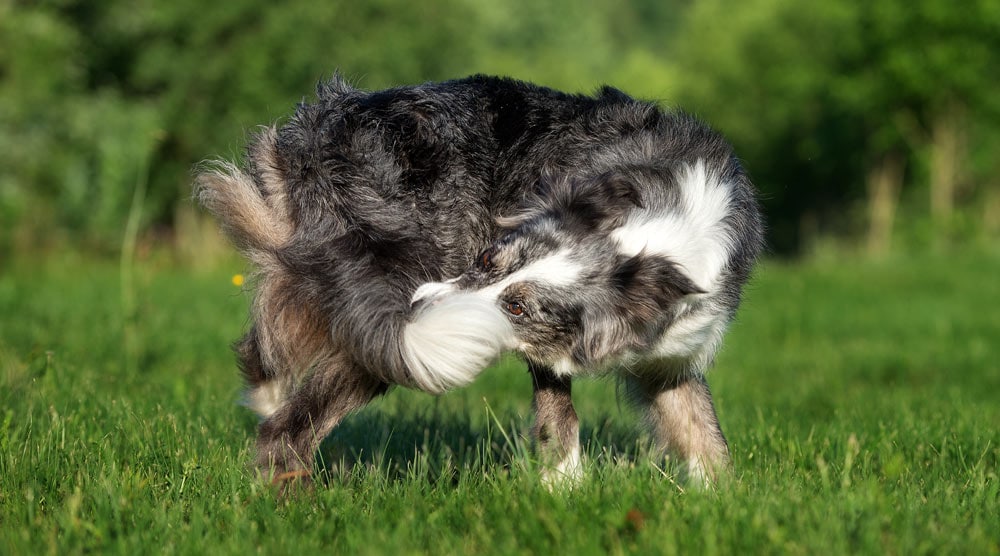Ever wondered if your dog can feel their tail? The answer is yes! Just like other parts of a dog’s body, tails contain nerves that send signals back to the brain, so our pets can certainly feel their tail.
In this article, we’ll discuss tail anatomy, including bones, nerves, and muscles. We’ll also explain why dogs feel pain in their tail, and some common issues that might need veterinary treatment.
Contents
Can Dogs Feel Their Tails?
Yes, dogs can definitely feel their tails.
Despite some dog owners believing their pets don’t have much feeling in their tail, canine tails have many nerves and pain receptors. These send direct feedback to the nervous system whenever the tail is touched or wounded.
The result is that dogs can sense everything from a light brush against their tail to the pain of a possible injury.
“I think the misconception of reduced feeling in a dog’s tail may stem from the fact that breeders used to dock tails of young puppies without any pain relief or anaesthesia,” says vet Dr Linda Simon. “Thankfully, we’ve moved on from this inhumane procedure in the country I work in”.
What Is a Dog’s Tail?
To understand why dogs feel their tails, it’s important to know the basics of tail anatomy.
A dog’s tail is an extension of its spine. Structurally, it’s built with caudal vertebrae bones, which get smaller the further they are down the tail. The number of these vertebrae varies by breed. Some short-tailed breeds have as few as five, while others may have up to 23.
There are also cushion-like discs between the vertebrae that let the bones smoothly glide over each other. Muscles then attach to the caudal vertebrae to provide tail movement.
Nerves run through the tail too. These allow the dog to control the tail, while also sending pain signals to the brain when needed. Given this anatomy, it’s clear that a dog can both feel their tail and have some level of conscious control over its movements.

The Purpose of a Dog’s Tail
Dogs use their tail for multiple purposes. For example, tails help maintain balance, by moving in the opposite direction when a dog changes course. They also act as a rudder when swimming.
Additionally, tails are key tools for communication, conveying a range of emotions through different types of wags. For example, a fearful dog may hold the tail down, while an extremely happy dog will wag it in a “helicopter” pattern.
Want to dive deeper into the role of a dog’s tail? Visit our guide to why dogs have tails.
Do Dogs Feel Pain in Their Tails?
Just like any other part of their body, dogs can experience pain and other physical sensations in their tails. In fact, as tails are always moving and fairly exposed, they are more prone to injury than other parts of a dog’s body.
For example, it’s common for tails to get stepped on, caught in a door, or wagged against a hard surface, leading to pain. Tail trauma could result in bruising, swelling, bleeding, and potentially even fractures or nerve damage.
Dogs with long, flowing tails are more susceptible to injuries than those with short tails. That said, any dog, regardless of tail type, can suffer from a tail injury.
Injuries aren’t the only potential cause of pain in a dog’s tail. For example, skin conditions may cause hot spots or irritation, which can cause a dog to chew their tail to get relief. There are also nerve conditions that can cause tail discomfort.
While there’s no question dogs can feel pain in their tails, some people believe tails might not be as sensitive as the rest of a dog’s body. However, there’s no concrete evidence to support this.
Do Dogs Understand It’s Their Tail?
Dogs sometimes chase their tails like separate playthings, and they often seem to wag their tails without conscious thought. So, do dogs know their tails are part of their bodies?
In short, yes. Dogs recognize their tails as a part of themselves – even if it doesn’t always seem that way!
Tail chasing is often a normal play behavior, especially in puppies. However, tail chasing can become problematic if it turns excessive, obsessive, or harmful, so it’s something to keep an eye on.
And, while it’s true that tail wagging is often a subconscious behavior for dogs, this doesn’t mean they’re not aware of their tail. Dogs can bring awareness and control to their tail when necessary.
Do Dogs Like Their Tail Stroked or Touched?
Most dogs don’t enjoy having their tails stroked. While there are always exceptions, it’s best to focus petting on other areas of a dog’s body and avoid touching the tail.
Why is this? The tail is a vulnerable and sensitive part of a dog’s anatomy. Stroking it can feel uncomfortable or unpleasant, which is why many dogs will move away or startle when touching their tail. Some dogs may even growl if their tail is touched.
So, respect your dog’s wishes. If they dislike having part of their body stroked, don’t push it. Continual tail stroking can cause stress and may make your dog defensive.
You should also never pull a dog’s tail. This can cause significant pain and potential injuries, including a dislocated tail.
On the other hand, many dogs like being scratched just above their tail. There are many nerve endings in this area, making it a pleasurable place to be scratched.
Can a Dog Injure Their Tail?
Yes, dogs can certainly injure their tails, with potential injuries ranging from minor abrasions to fractured vertebrae. Here are some common types of dog tail injuries:
- Abrasions and lacerations: Abrasions are small, shallow cuts on the tail. Deeper cuts are known as lacerations, which can reach down to the bone. These are usually caused by an external object or the dog hitting its tail on a hard surface.
- Tail fractures: A broken tail vertebrae is very painful. It’s often caused by the tail getting slammed in a door, but can also occur when a dog wags its tail against a wall or other hard surface. Puppies may also be born with a broken, kinked tail that occurred in utero.
- Happy tail syndrome: Happy tail is a serious condition where the dog repeatedly hits its tail against a surface, causing wounds. In severe cases, amputating part of the tail may be the only solution.
- Limber tail: Limber tail syndrome causes the tail to hang down limply, often due to overuse. It’s sometimes called “swimmer’s tail,” as it’s common after swimming in cold water.
- Tail dislocation: A dislocation is often caused by someone pulling the tail. This results in a dislocation at the base and is very painful for the dog.
- Tail nerve damage: The nerves in the tail can be damaged if stretched. Since the nerves at the base of the tail are involved in bowel movements, this can sometimes lead to incontinence.
Note: Tail docking is the practice of amputating a young puppy’s tail without anaesthetic, often for aesthetic reasons. It’s a very painful procedure that can lead to chronic issues, while also making it more difficult for the dog to communicate. For this reason, The Dog Clinic is firmly against tail docking, unless it is a medical necessity.
What Should I Do If My Dog Has a Tail Injury?
If you suspect that your dog has a tail injury, it’s crucial to contact your vet as soon as possible. Tails are sensitive, and an injured tail can cause significant pain and distress. A tail injury can also make it harder for your dog to communicate.
Signs of a tail injury can include:
- Visible wounds
- Sensitivity or soreness
- Swelling
- Bleeding
- Drooping tail
- Kinks or bumps along the tail
- Changes to your dog’s wagging behavior
- Vocalizations such as whimpering or crying (or letting out a yelp when tail touches something)
- Difficulty standing or walking
- Guarding the tail
- Changes to behaviour
To accurately diagnose a tail injury, your veterinarian might perform a physical exam of the tail area and take medical images. Depending on the symptoms, they may also take skin scrapings or perform blood tests.
Also, keep in mind that a tail injury can sometimes mimic other conditions. “Diseases like anal furunculosis and anal gland abscesses can cause a dog to hold their tail low and vocalize,” says vet Dr Linda Simon. “Many owners I see suspect a tail injury, but we then find there is something else entirely going on.” So, a visit to the vet is essential!
Summary
Dogs can feel their tails, with nerves and muscles providing sensations and movement. They also understand that the tail is part of their body and generally don’t like it to be touched.
Unfortunately, dogs can suffer from various tail injuries that may cause pain. Quick veterinary intervention is always important if you suspect that your dog has issues with their tail.




